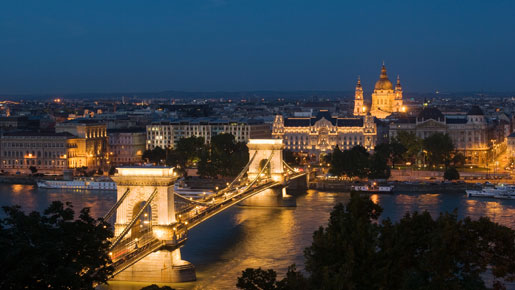
The River Danube winds through the heart of Hungary’s capital. On its western bank, Buda’s monumental Hapsburg palace crowns a green, wooded and craggy hill, where the pinnacled spire of Mátyás church soars above a colourful glazed tile roof and a dark interior painted in patterns reminiscent of Turkish carpets. Nearby, fairytale towers and turrets define the strange folly that is Fishermen’s Bastion, with stone arches framing a picture-perfect view of the country’s striking, Westminster look-alike parliament buildings across the river in the contrasting flatlands of Pest. The two ancient rival towns, Buda and Pest, were united in 1873 by the sturdy girders of the Chain Bridge.
Its wide streets and squares lined with elegant Austro-Hungarian Empire architecture and flourishes of Art Nouveau, Pest is the lively, 21st-century side of the city. Centre of business, shopping, culture and nightlife, it buzzes with cool cafés, hip bars and clubs, sleek restaurants and stylish luxury hotels.
Leafy Ándrassy boulevard, Budapest’s UNESCO-listed answer to the Champs Elysées, is home to the opulent State Opera House with its frescoed ceilings, gilded walls and fine acoustics. The former booking office across the road has become the Callas Café, brilliantly imagined by British interior designer David Collins. Under vaulted ceilings and soaring, ornate plaster and mosaic-decorated arches, it retains the traditional feel of the lovely old Budapest coffee houses, yet works superbly as a café-brasserie by day and at night slips seamlessly into a lively restaurant and bar. Louis Vuitton and Chanel have boutiques nearby.
Heartland of the city’s café society for nearly a century, the gloriously extravagant New York café and restaurant has been triumphantly resurrected as part of the long-awaited New York Palace hotel. Built around an atrium, the hotel is fashionably modern and boasts an extraordinary Ice Cave spa.
Countless underground thermal springs turned Budapest into one of Europe’s great spa cities. Classy though the 5-star hotel versions are, there’s nothing like experiencing the traditional style. Join locals in the outdoor pools of the neo-baroque Széchenyi Spa Baths, swim alongside marble columns in the Art Nouveau setting of the Géllert, or allow your body to be steamed and pummelled amid the grandeur of a 16th-century Ottoman bath palace.
From Roman mosaics, Gothic spires, neo-Classical domes and a Byzantine synagogue to fancy Baroque façades and sinuous Secessionist lines, Budapest wears its long history for all to admire. Many of the most important buildings date from 1896, when Hungary went on a building spree to celebrate the Magyar millennium. The underground Metro dates from this period. It was the first on continental Europe, and second only to London’s Tube.
The Liberty Monument atop Géllert Hill is one of the few Soviet-era landmarks still left in place. The symbolic Statue Park, out of town and worth the trip, is where many of the city’s monuments to communist power ended up. Amid the designer elegance of Ándrassy útca, a state-of-the-art museum presents a stark reminder of 20th-century life and times. Its setting, the former Nazi and dreaded ÁVO secret police headquarters, and its name, The House of Terror, say it all.
But Budapest, while remembering its past, has its eye on a glittering future. The Bank Centre’s four 10-storey towers, clad in polished granite and reflective glass that mirrors surrounding historical façades, take up a full city block at the heart of the banking and financial district.
Take a summer boat trip on the Danube, hop aboard the funicular that clambers up to the cobbled streets and squares of the Castle District, and get your fill of a world of great art in the numerous galleries. And for the sheer romance and beauty of it, stroll along the Pest embankment at night – Buda’s floodlit buildings are magnificent. Stay in some of the best hotels in Europe, enjoy the restaurants, the food and the nightlife. Budapest is a city that never ceases to surprise.

